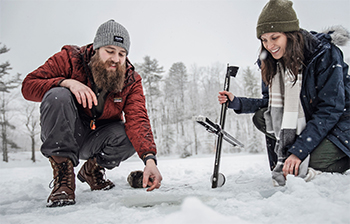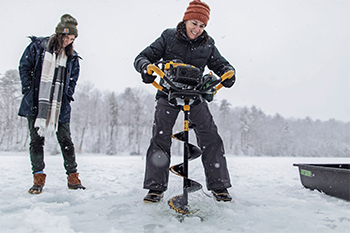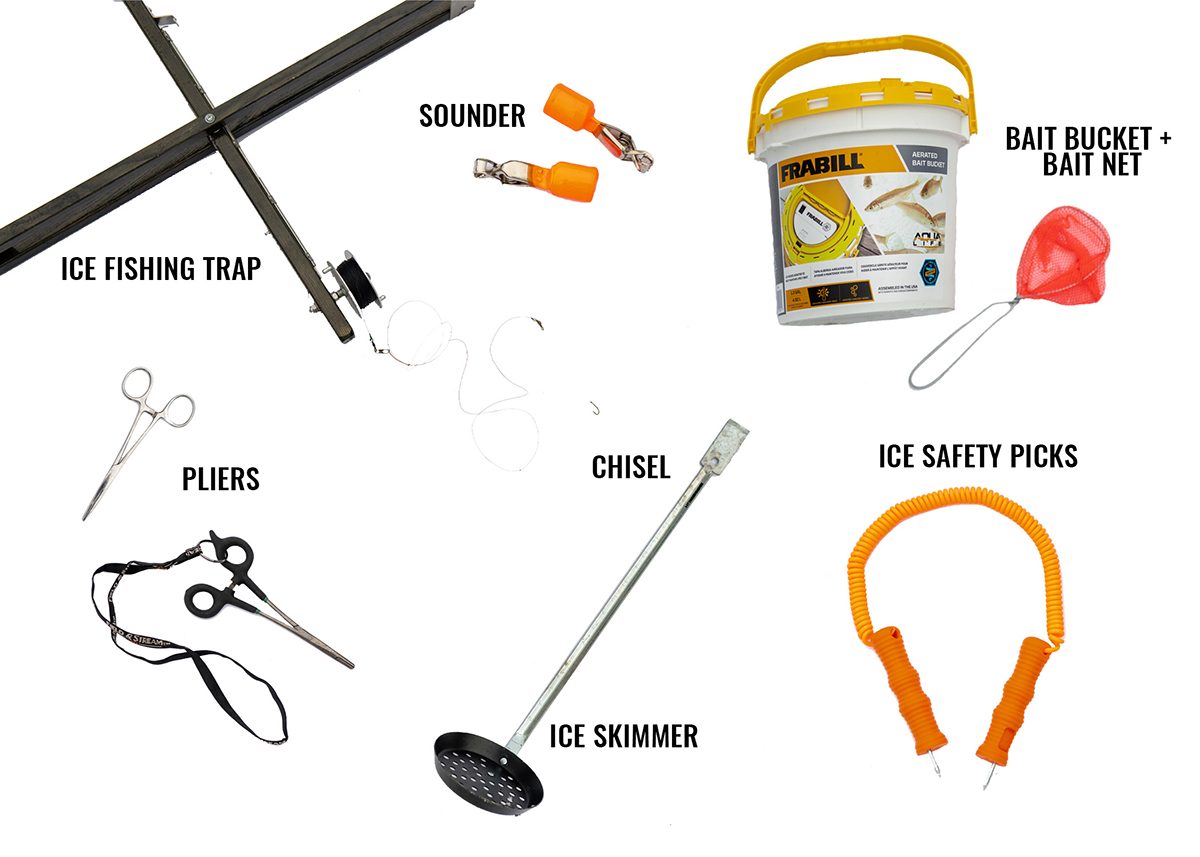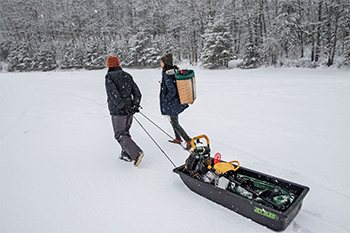Home → Fishing & Boating → Fishing → Ice Fishing Guide
A Beginner’s Guide to Ice Fishing in Maine

Starting a new hobby can be both exciting and intimidating, luckily ice fishing is a winter hobby that can be enjoyed with a few pieces of equipment and there are endless opportunities throughout the state. For many outdoor enthusiasts, ice fishing is one of the most revered times of the year. Not only can you fish for many different species, but you can create memories with friends and family, spend time outside, enjoy some beautiful scenery, and can provide you with some delicious table fare.
This guide is written for anyone who has been curious about ice fishing but didn’t know where to begin and will cover these three questions:
1. What gear and equipment do I need?
Before we start with gear, the absolute first thing you need to do before heading ice fishing is to buy your Maine fishing license. You can purchase a fishing license online at mefishwildlife.com and children under 16 do not need a fishing license to ice fish.
Now, what do you really need to start ice fishing this year? Like most activities, there are a ton of items that you could use but getting set up with the essentials is all you need to start.
Proper clothing: You are going to want to dress for the conditions. It might seem like common sense but while recreating in below freezing temperatures you need to have the proper clothing. Nothing ruins a day of ice fishing like getting cold or wet. Insulated boots, waterproof gloves, thermal layers, a warm beanie, and wool socks are some of the staples. It’s smart to bring extras of almost everything, that way if gloves, socks, or a hat gets wet, you have a warm dry pair ready to use. Warm clothing doesn’t need to be expensive or even ice fishing specific. Snow pants, bibs, down jackets, insulated boots, bomber hats, and fleece lined waterproof work gloves are great places to start. Also, don’t hesitate to choose your days based on the weather. If it is below zero and windy, you probably won’t have as much fun!

A chisel or auger: Ice fishing can be a gear heavy activity, but it doesn’t have to be. At the most basic level an angler can go ice fishing with just an ice chisel and a jig rod with some sort of bait or lure. That’s it. Very few strip it down to that basic level but the first thing you will need is some sort of way to make a hole in the ice. An ice chisel is most effective early in the season but can also be used as a safety tool to check ice thickness throughout the season. An ice auger is the most commonly used tool to drill holes through the ice. There are many options whether it’s a hand, electric, gas, or propane powered auger. Which one you choose typically depends on your budget, but they all work. A hand auger is most often the cheapest and best way to get started, paired with a sharp blade a hand auger gets the job done easier than you might expect. A powered (gas, propane, or electric) auger is often the most expensive piece of equipment (but most popular), so if you are just starting out, you may opt to join friends and borrow their auger until you are ready to invest more in the hobby.

Traps and tackle: The real purpose of ice fishing is that obvious; to catch fish. The next essential piece of gear you’ll need is a way to catch those fish. Setting “traps” or “tip-ups” paired with live bait is probably the most common way to fish through the ice in Maine. A trap or tip up is simply a device that sits on top of the ice, holds the fishing line, and has an indicator flag that “trips” when a fish tugs on the line. There isn’t a trap out there that won’t work, but like with anything, more expensive traps tend to be better made and last longer. Some popular brands are Polar, Frabill and some Maine-made brands like Heritage and Jack Traps. Another option is a jig rod. Jig rods are essentially mini fishing poles and are also very popular with ice anglers that prefer a more active style of fishing. A combination of jigging and setting a few traps is how some prefer to fish. In most Maine waters, you can have five lines set (traps and jigging combined) at one time, so most anglers tend to own five traps total.
You will need some tackle to attach to the end of your line. There is no “one way” to set up your line, but a standard approach is your standard ice fishing line, then a piece of monofilament line, a swivel, then another piece of monofilament line with the hook. Attach a small, nonlead weight to the leader as needed. Check out YouTube for other setups and tips for tying knots. A go-to hook size is a #6, but if using small smelts for salmon, a #8 may be better. For those fishing off bottom for lake trout (togue) a larger hook may be preferred.
Besides the absolute essential gear needed to cut the ice and a rig to fish with, there are a few other pieces of gear that you’ll need. Here is a list of some additional essentials that will help make your ice fishing trip a success:
- A sled – This makes bringing your gear from your vehicle to your fishing spot much easier. There are sleds designed for dragging a lot of gear across the ice, but even a child’s plastic sled can get the job done if you’re packing light.
- Bait bucket and bait net – You’ll need a way to safely transport your bait. Don’t forget the net or your hands will get wet and cold trying to get your bait out of the bucket. On the day of or night before your fishing trip, stop at a local bait shop with your bucket before you go fishing. Click here to find a bait and smelt retailer near you.
- Ice scoop or “skimmer” - To get the floating ice chunks out of the hole after your drill it.
- Pack basket or large backpack – A place to store and carry your traps, clothing, and gear.
- Creepers or ice cleats – These slide over your boots to prevent falling on the ice when there isn’t a good covering of snow.
- Fishing pliers – To remove the hook when you catch a fish.
- Depth sounders – A simple weight temporarily attached to the end of your line to find the depth of the water when setting your trap.
- Hand and foot warmers – Just in case!
- Ice safety picks – As long as you check the ice, your chance of falling in is slim, but these picks are attached to a string and can be worn around your neck and are a best practice just in case.
- Chisel – To check the ice thickness and to break up the ice in your hole if it freezes.
- Food/ thermos of some sort of hot beverage – It makes the day that more enjoyable!
- Sunglasses and sunscreen – This may be surprising, but when the sun reflects off the ice or snow, sunglasses and sunscreen can save the day.
Hot-tip: When bringing children ice fishing, bring other things to keep busy while the traps are in between fish biting. Frisbee, football, or ice skates are good ways to keep everyone active. Also, good food often makes the trip for everyone involved, no matter how fast the fishing is.
2. Where should I go ice fishing?

Now that you’ve got some of the essential gear, how do you pick a spot to ice fish? Across the entire state of Maine, no matter where you live, there are opportunities close to home.
- Check the Monthly Fishing Report - Each month regional fisheries biologists provide some of the best places to fish that month in each part of the state, complete with tips and recommended species to target.
- Call your local MDIFW headquarters - A regional biologist will be happy to share additional locations that didn’t make it on the fishing report.
- Check the stocking report - The stocking list is organized by county which makes it easy for you to find waters close to you. Lakes and ponds stocked with brook trout in the fall offer some of the best fishing opportunities in the winter.
One of the best ways to get started ice fishing is fishing for warmwater species like yellow perch, largemouth bass, and pickerel. These species often make for fast fishing and can keep you running to flags all day long. You can identify waters with these species as well as additional fishing opportunities by viewing the Maine Fishing Guide - Google Earth Layer (learn which fish species are present in lakes and ponds and public access sites) and the Fishing Laws Online Angling Tool (learn the special fishing regulations on all of Maine’s waters).
Once you have selected a water body, look up the fishing laws at mefishwildlife.com/fishinglaws or use the Fishing Laws Online Angling Tool.
3. What do I do when I arrive?

Safety first. Before you go, always make sure someone knows where you are going and when you expect to return. When you arrive at the pond or lake, you’ll first want to check the ice thickness. Use your chisel or auger to make several test holes. Remember that ice quality and thickness can vary from one spot on a lake to another. Stay away from rock piles and inlets and outlets or anywhere water could be moving as ice tends to be thinner in these areas. Learn more about ice safety.

Set your traps.
- Find your spot. When you arrive and are ready to set up, where you set your traps or start jigging really depends on what species of fish you are fishing for. A smart way to approach this is setting traps in various depths in different habitats. Some of the most popular species caught through the ice (brook trout, bass, pickerel, salmon) can all be caught in 15 feet of water or less in association with the shoreline. This makes it simple, just look for some natural features like rocky shorelines, points, and islands to set traps around. If the fishing is slow at your first spot, don’t be afraid to move your location until you find some feeding fish.
- Drill your hole. Now that you’ve found your spot, it’s time to drill a hole. When setting traps close to shore, you may opt to play it safe and drill somewhere where you know you won’t hit a rock (a dull auger will make drilling your remaining holes a real pain!)
- Skim it! Once drilled, you will need to clean all the ice chunks out of the hole with your ice scoop/skimmer. Keeping the hole clean of ice will make it easier to get your bait set and to get a fish out of the water. Don’t be afraid to look down into your hole and check to see what the lakes substrate looks like; you may even see some fish!
- Check the water depth using your sounder. Simply clip the sounder on your line, hold your trap, and put the line down the hole. When the line goes slack, you have found the bottom. Note the depth of water on the line and pull it back up.
- Set the trap. Most fish will either be found just a few feet under the ice or up a few feet off bottom. A rule of thumb many ice anglers follow is to set a few traps “just under the ice” which means having your line and bait set a foot or two under the bottom of the ice. Once you have your line depth set, put the baitfish or worm on your hook (check to make sure it is secured and won’t wiggle off).
- Double check it. Once your trap is set, make sure if the line gets pulled it will trigger the flag to be tripped. Set the trap on the ice and now you are fishing! Repeat this process for each trap. Hint: if the trigger is not going to set off the flag, check to make sure the line is wrapped around the reel in the correct direction.
- Check your bait every hour. Make sure your bait is still hooked and lively. If the bait is not lively, replace it with a fresh bait. Keep in mind that not all waters allow live bait, check the lawbook before you go. You may need to use worms or even an artificial lure.

Flag! When you see a flag go up, be sure to get there as quick as possible. Gently pick up the trap and grab the line. A short, quick tug on the line will set the hook. Bring the line in hand over hand, keeping steady pressure and tension and letting the fish take line if it runs. As soon as you land the fish (bring the fish through the hole onto the ice) you need to act quickly. Use pliers to remove the hook from the fish and if the hook is too deep for pliers just cut the line as close to the fish’s mouth as possible (the hook will dissolve naturally). If you plan on keeping the fish, make sure it meets the legal length requirements with a tape measure. If the fish is not legal, or you just decide you’d like to release the fish, please do so as fast as possible. A gentle, quick release will give the fish the best chance of survival after the catch. Once it’s released, it is time to rebait and do it all over again.

Packing up. When it is time to call it a day, remember to never dispose of bait (dead or alive) in the water or down your hole. Many anglers try to keep unused bait alive until the next time they go fishing or dispose of it when they return home.
Store your gear carefully to prevent line tangles and set your traps in a spot where they can thaw out and dry. Taking the time to neatly pack your gear will save you from a mess that could potentially discourage you from going out a second time or slow your set up down the next time on the ice.

Enjoy your catch. If you decided to bring home your catch be sure to clean and prepare properly. If you are looking for recipes to try, here are few favorites from MDIFW staff.
We look forward to hearing about your ice fishing adventures! Most ice anglers acquire gear over a multitude of years, so don’t feel like to be successful you need to buy the best of the best all at once. A few traps and a few pieces of gear a year will add up quickly. If you are an experienced angler already, becoming a mentor can be fulfilling and is a very helpful tool in getting people into ice fishing, so don’t be afraid to ask a friend if they want to tag along.